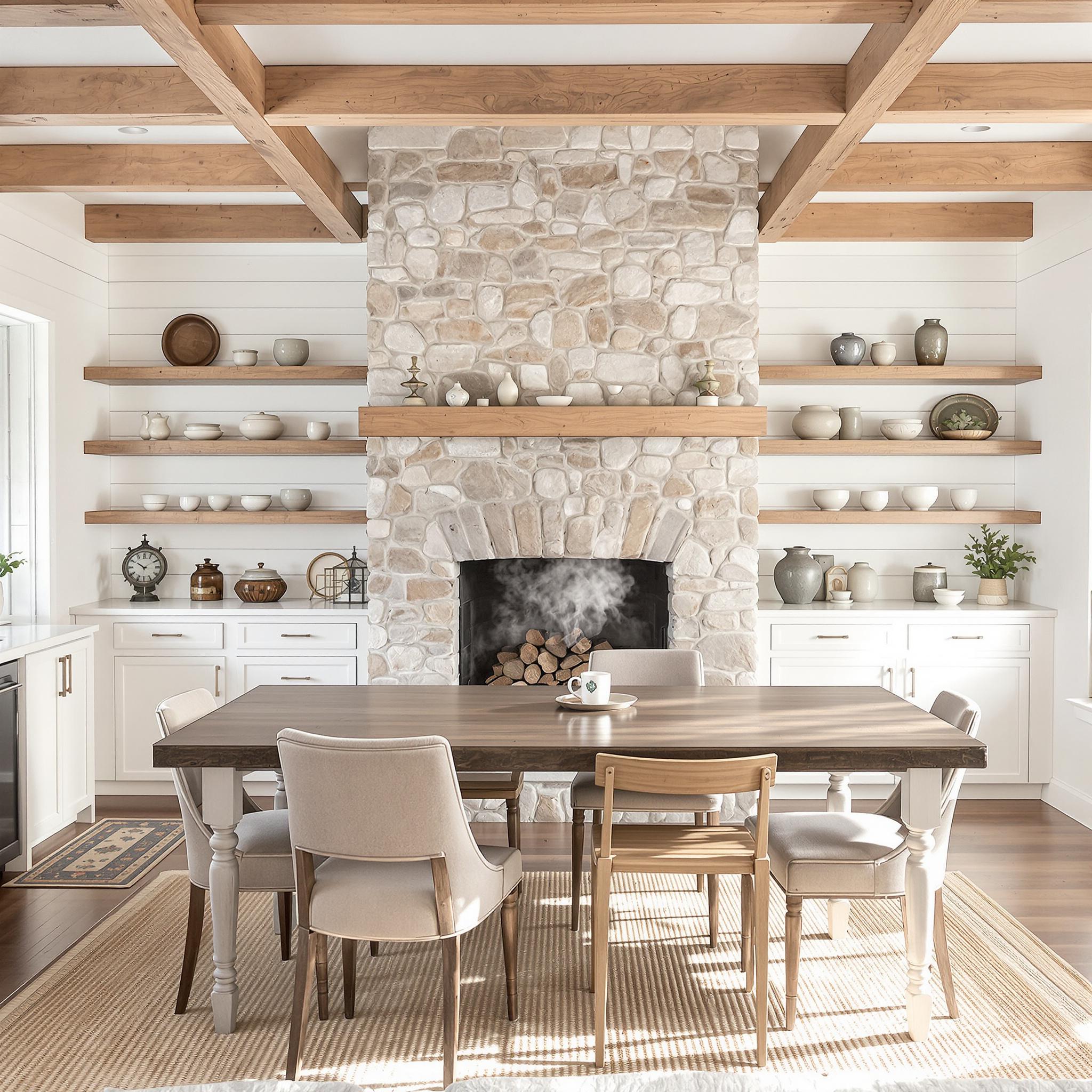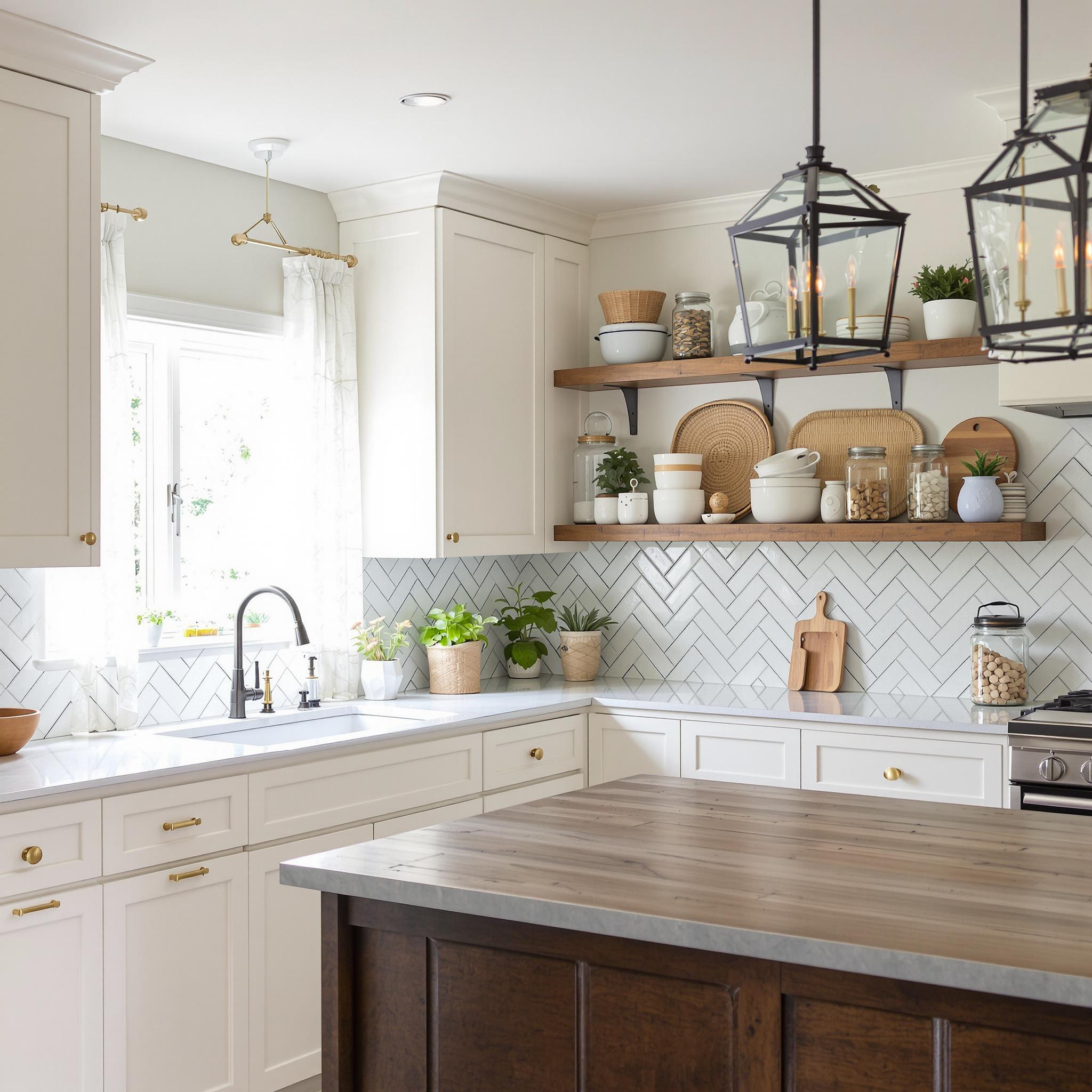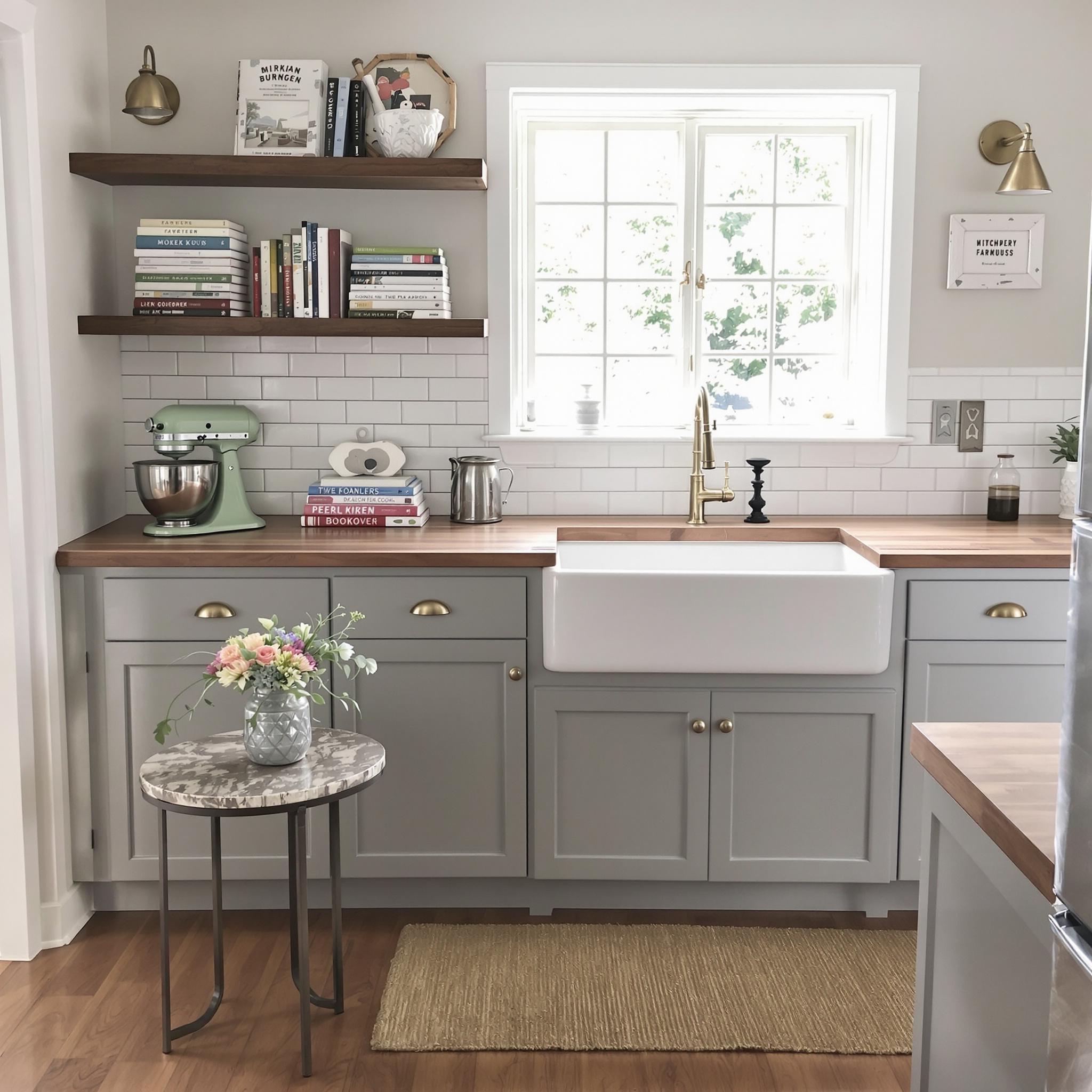What Makes Farmhouse Kitchen Design So Timeless?
Farmhouse kitchens blend practicality with charm. They feel warm, inviting, and lived-in. This style has been popular for decades. Why? It mixes function with a cozy vibe. Think of grandma’s kitchen—simple yet full of heart.
The farmhouse look works in any home. It feels timeless because it avoids trends. Instead, it focuses on natural materials and classic details. Wood, stone, and metal shine here. These elements never go out of style. They ground the space and make it feel real.
Key Features That Create Warmth and Comfort
Warm and cozy kitchens rely on specific features. These include textures, colors, and materials. Let’s break them down.
- Natural Materials: Wood beams, butcher block counters, and stone floors add warmth.
- Textures: Mix woven rugs, linen curtains, and rough-hewn wood for depth.
- Color Palettes: Stick to neutrals like white, cream, gray, and soft blues. Add pops of color sparingly.
These choices work together. For example, a wooden table with a distressed finish pairs well with soft, earthy tones. The mix feels layered but not cluttered. It invites people to sit and stay awhile.
Why a Welcoming Kitchen Matters
Kitchens are more than places to cook. They’re the heart of the home. A warm kitchen makes people feel at ease. It encourages connection. Imagine sipping coffee at a rustic island while sunlight streams in. Sounds nice, right?
A cozy kitchen also boosts mood. Soft lighting, warm hues, and tactile surfaces create comfort. You’ll want to gather there with family and friends. Emotional impact matters in design. A welcoming space fosters joy and togetherness.
Finding Your Style Within Farmhouse Design
Farmhouse kitchens offer flexibility. You can adapt the style to fit your personality. Start by asking yourself some questions.
- Do you prefer sleek lines or rustic charm?
- Are you drawn to light, airy spaces or rich, moody tones?
- Do you love vintage pieces or modern updates?
Your answers guide your choices. For instance, if you lean toward clean lines, opt for shaker cabinets. If you love vintage vibes, hunt for antique hardware. Mixing old and new keeps things fresh.
How to Incorporate Farmhouse Elements Without Overdoing It
Balance is key in farmhouse design. Too many rustic details can overwhelm. Here’s how to get it right.
- Choose one standout piece: A farmhouse sink or reclaimed wood shelf adds charm without overkill.
- Stick to a neutral base: White walls or soft grays let other elements shine.
- Add personal touches: Display heirlooms or handmade items that tell your story.
I once helped a friend redo her kitchen. She loved the farmhouse look but worried about it feeling stiff. We added a colorful rug and her collection of pottery. The result? A space that felt both stylish and uniquely hers.
Materials That Define Farmhouse Kitchens
Certain materials scream farmhouse. They’re durable, functional, and beautiful. Here’s what to consider.
- Wood: Use it for floors, tables, or open shelving. Reclaimed wood adds character.
- Metal: Think copper pots, iron hooks, or brass fixtures. They add a hint of shine.
- Stone: Countertops or backsplashes in marble or granite bring elegance.
Mix these materials thoughtfully. Pair a stone countertop with a wooden island. Add metal barstools for contrast. Each choice should enhance the overall look.
Textures That Bring Life to Your Space
Texture transforms a kitchen from flat to fabulous. Layering different textures creates interest. Here’s how to do it.
- Fabric: Add cushions, curtains, or table runners in natural fibers.
- Surfaces: Combine smooth countertops with rough brick or stone accents.
- Decor: Hang woven baskets or display ceramic bowls for variety.
One client wanted her kitchen to feel cozy. We swapped plain chairs for upholstered ones. Then we added a jute rug under the dining table. The change was subtle but impactful. Her kitchen instantly felt warmer.
Choosing Colors That Feel Inviting
Color sets the tone in any room. Farmhouse kitchens thrive on muted palettes. These shades evoke calm and simplicity.
- Whites and creams: Brighten small spaces and highlight architectural details.
- Grays and beiges: Offer a neutral backdrop for bolder accents.
- Pastels: Soft blues, greens, or yellows inject personality without overwhelming.
Don’t shy away from contrast. Dark cabinets against light walls create drama. Just keep the overall effect balanced. Too much dark can feel heavy.
Making Your Farmhouse Kitchen Truly Yours
Every home tells a story. Your kitchen should reflect yours. Start with the basics of farmhouse design. Then tweak them to suit your taste.
For example, I worked with a couple who loved hosting. They chose a large farmhouse table as their focal point. Around it, they layered cozy textiles and plants. Their kitchen became a hub for laughter and meals.
Remember, farmhouse design isn’t rigid. It’s a starting point. Experiment until it feels right. Trust your instincts. After all, your kitchen should feel like home.
Cabinetry and Storage Solutions That Blend Functionality with Charm
Let’s start with cabinetry—it’s the heart of any kitchen, farmhouse or not. These kitchens need a mix of practicality and cozy charm. Shaker-style cabinets are a go-to. They’re simple, clean, and timeless. I used to think they were boring until I saw them paired with brass handles in a friend’s place. Instant wow factor.
Here’s a tip: mix materials and finishes. White base cabinets with a darker island or open shelves create depth without being too much. Open shelving is great if you keep it tidy. It’s perfect for grabbing what you need while showing off pretty dishes or jars. Just a heads-up—everything on display needs to look good.
Storage should be smart but not overdone. Pull-out spice drawers, corner carousels, or a hidden coffee station can make life easier. And don’t skip tall pantry units. They scream farmhouse and are lifesavers for storing big pots, pans, or bulk groceries.
Countertop and Backsplash Materials to Enhance Warmth and Durability
Now, countertops and backsplashes—they’re where function meets style. Butcher block counters feel warm and homey but need regular oiling. If you’re not into upkeep, skip this one.
For something durable yet inviting, try quartz or soapstone. Quartz looks like natural stone but doesn’t need much care. Soapstone develops a nice patina over time. There’s something satisfying about counters that get better with age.
Subway tiles are classic for backsplashes, but why stop there? Try a herringbone pattern or handmade ceramic tiles with slight imperfections. Once, I saw a teal Moroccan tile backsplash in a café—it was stunning. It made me want to get creative in my own kitchen.
- Pro tip: Carry the backsplash material up to the ceiling for drama.
- If your budget allows, go for a marble slab. It’s luxe but still fits the farmhouse vibe.
Lighting Choices: Pendant Lights, Sconces, and Natural Light Integration
Lighting makes or breaks a cozy farmhouse kitchen. Harsh fluorescents? No thanks. Instead, hang pendant lights above your island or sink. Picture black wrought-iron fixtures casting soft shadows. Beautiful, right?
Sconces are another great option. Put them near windows or by the stove for task lighting that doubles as decor. I love brass sconces with glass shades—they’re elegant but not fussy. Just get the height right. Too high, and they lose impact; too low, and they’re in the way.
Natural light is key. Nothing beats sunlight streaming through windows. Add skylights if you can. I once skipped curtains for privacy—and ended up waving at neighbors every morning. Sheer curtains solve that problem while keeping things bright.
Decorative Elements Like Open Shelving, Vintage Accents, and Plants
Time for the fun part—decor! Open shelving is already a farmhouse staple, but styling matters. Mix functional items like baskets and jars with decorative pieces like antique pitchers or art. Keep it curated, not cluttered. Less is more here.
Vintage accents give an authentic farmhouse feel. Check flea markets or online for treasures like old scales, enamelware, or retro mixers. Last summer, I found a mint green stand mixer at a garage sale. It’s now the star of my baking setup. Pro tip: stick to a couple of metal finishes to avoid chaos.
Plants are a must. A trailing pothos or succulents on the windowsill add coziness. Herbs like basil or rosemary do double duty—greenery and flavor. Plus, caring for plants feels rewarding—even if you accidentally kill one now and then.
Flooring Options That Complement the Farmhouse Vibe While Ensuring Practicality
Finally, let’s talk flooring. Hardwood is classic farmhouse but prone to scratches. If you’ve got kids or pets, engineered hardwood might be smarter. It’s tougher and still looks great.
Tile is another solid choice, especially in patterns like hexagons or chevrons. It adds interest and handles spills well. Large-format tiles can make small kitchens feel bigger. Remember that café with the teal backsplash? Their checkered tile floor tied everything together perfectly.
Rustic vinyl plank flooring is trending too. It looks like wood but costs less and handles heavy traffic. I debated between real wood and vinyl during my remodel. I went with vinyl and haven’t regretted it. Sometimes practicality wins.
Don’t forget rugs! A runner or area rug by the sink or table adds warmth and cushions feet during long cooking sessions. Just make sure it’s machine washable—you’ll thank me later.
There you have it—a guide to creating a cozy, functional farmhouse kitchen. Whether you’re starting fresh or updating, these ideas will help you nail the look and feel you want.
Adding the Finishing Touches to Your Farmhouse Kitchen
You’ve probably heard this before: details matter. And in a farmhouse kitchen, those small touches make all the difference. The goal is to create a space that feels cozy and lived-in, like it’s been there forever. But how do you do that without making it look old or messy? Balance is key.
Start with textures. Mixing materials adds warmth and depth. Maybe you have a sleek quartz countertop but pair it with a reclaimed wood island. I once saw someone use old barn doors as cabinet panels. It looked amazing—like her kitchen had history but still worked for modern life.
Open shelving is another great way to add charm. Yeah, it might feel scary at first—who wants their mismatched mugs on display? But it’s a chance to show off your style. Group woven baskets, vintage pitchers, or cookbooks. Just don’t overdo it. Too much clutter ruins the vibe.
Hacks You Didn’t Know You Needed
Let’s talk budget-friendly tricks because Pinterest dreams can get pricey. How do you get that farmhouse look without spending a fortune? Here’s the deal: paint your cabinets instead of replacing them. White paint brightens the space and gives it that classic farmhouse feel. If white feels too stark, try soft gray or sage green. Swap out hardware for something rustic, like black iron pulls or brass knobs. Seriously, it makes a huge difference.
Another hack? Use peel-and-stick backsplash tiles. They’re cheap, easy to install, and come in farmhouse-friendly designs like subway tile or brick. Best part? You can switch them out later without damaging your walls. I used these in my own kitchen, and no one noticed they weren’t real tile.
Avoiding Those Oops Moments
Now, let’s talk about mistakes because we’ve all made them. One big one is cramming too many farmhouse elements into one space. Instead of feeling cozy, it starts to feel overwhelming. Do you really need a farmhouse sink, shiplap walls, exposed beams, AND a butcher block countertop? Probably not. Pick a couple of features and let the rest breathe.
Here’s a funny story: a neighbor went overboard with the “rustic” theme. Distressed wood everywhere, heavy iron fixtures, and so many antiques crammed in that there was barely room to move. It looked cool in pictures, but in person? Felt more like a museum than a kitchen. Take it from her: less is more.
And please, don’t forget about lighting. Bad lighting kills the mood fast. Skip the harsh fluorescents and go for warm, layered options. Pendant lights over the island, sconces by the sink, or even a statement chandelier if you’re feeling fancy. Just keep it proportional to your space.
Modern Meets Rustic: Finding Harmony
Farmhouse kitchens are charming, but nobody wants to give up modern conveniences. Imagine washing dishes by hand every night because your sink doesn’t have a garbage disposal. Not fun. The trick is blending old and new seamlessly.
For example, smart appliances can blend right into your design. Stainless steel fridges are great, but newer models with panel-ready fronts hide in plain sight. Same goes for under-cabinet outlets or built-in charging stations. These upgrades make life easier without looking futuristic.
Don’t overlook storage either. Farmhouse kitchens often lack cabinet space due to open shelving. But there are ways to maximize what you’ve got. Pull-out pantry racks, corner drawers, and vertical organizers help you stay clutter-free. I didn’t realize how much I needed pull-out shelves until I installed them. Total game-changer.
Final Thoughts Before You Get Started
At the end of the day, your farmhouse kitchen should reflect you and how you live. Whether you’re on a tight budget or splurging on a remodel, every choice should bring you closer to that cozy, welcoming vibe you want.
So mix in those vintage finds, play with textures, and trust your gut. The best farmhouse kitchens aren’t just pretty—they’re spaces where memories happen. Happy decorating!
FAQs About Creating Your Dream Farmhouse Kitchen
- What defines a farmhouse kitchen?
Farmhouse kitchens have rustic elements like shiplap walls, apron-front sinks, and wood finishes. They also focus on functionality and comfort. - Can I achieve a farmhouse look on a tight budget?
Yes! Repaint cabinets, use peel-and-stick backsplash tiles, and add thrifted decor. Small changes can make a big impact. - Do I need a farmhouse sink?
Not really. While they’re iconic, plenty of other sinks work well. Choose one that fits your lifestyle and style. - How do I choose the right color palette?
Stick to neutral tones like white, gray, and earthy hues. Add pops of color with accessories or accent walls. - Should I DIY parts of the project?
If you’re handy, go for it! Painting or installing hardware is beginner-friendly. For bigger tasks, hire a pro to avoid costly mistakes. - What’s the best way to incorporate modern appliances?
Go for sleek, integrated designs that blend with your cabinetry. Smart appliances offer convenience without ruining the rustic look. - How do I prevent my kitchen from looking too cluttered?
Stick to a few key farmhouse elements and edit ruthlessly. Only display items that truly spark joy. - Is lighting really that important?
Yes! Layered lighting creates warmth and highlights details. Avoid harsh overhead lights and use softer options like pendants and sconces. - Can I mix different styles?
Of course! Combining farmhouse with industrial or Scandinavian touches can create a unique look. Just keep it cohesive. - How do I maintain the balance between rustic and modern?
Choose timeless materials like wood and metal, but pair them with clean lines and updated tech. Think harmony, not competition.



